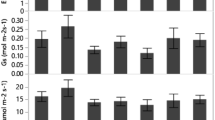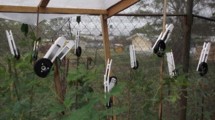Abstract
Responses of the endemic leguminous shrub Bauhinia faberi var. microphylla, to various soil water supply regimes were studied in order to assess water stress tolerance of seedlings. Two-month-old seedlings were grown under water supply regimes of 100, 80, 60, 40, and 20% water field capacity (FC), respectively, in a temperature and light-controlled greenhouse. Plant height and leaf number were measured monthly over a 4-month period, while water use (WU), water-use efficiency (WUE), leaf relative water content (RWC), biomass production and its partitioning were recorded at the end of the experiment. Seedlings exhibited the greatest biomass production, height, basal diameter, branch number, leaf number, and leaf area when soil content was at 100% FC, and slightly declined at 80% FC. These parameters declined significantly under 60% FC water supply, and severely reduced under 40 and 20% FC. RWC, WU and WUE decreased, while the ratio of root mass to stem mass (R:S) increased in response to decreasing water supply. Water stress caused leaf shedding, but not plant death. The results demonstrated that B. faberi var. microphylla seedlings could tolerate drought by reducing branching and leaf area while maintaining a high R:S ratio. However, low dry mass and WUE at 40 and 20% FC suggested that the seedlings did not produce significant biomass under prolonged severe water deficit. Therefore, before introducing B. faberi var. microphylla in vegetation restoration efforts, water supply above 40% FC is recommended for seedlings to maintain growth.




Similar content being viewed by others
References
Akhter J, Mahmood K, Tasnweem MA, Malik KA, Naqvi MH, Hussain F, Serraj R (2005) Water-use efficiency and carbon isotope discrimination of Acacia ampliceps and Eucalyptus camaldulensis at different soil moisture regimes under semi-arid conditions. Biol Plant 49(2):269–272
Anyia AO, Herzog H (2004) Water-use efficiency, leaf area and leaf gas exchange of cowpeas under mid-season drought. Eur J Agron 20:327–339
Ares A, Fownes JH (1999) Water supply regulates structure, productivity, and water use efficiency of Acacia koaforest in Hawaii. Oecologia 121:458–466
Bañon S, Fernandez JA, Franco JA, Torrecillas A, Alarcón JJ, Sánchez-Blanco MJ (2004) Effects of water stress and night temperature preconditioning on water relations and morphological and anatomical changes of Lotus creticus plants. Sci Hortic 101:333–342
Bao WK, Cheng QH, Chen KM (1999) Environment control techniques for vegetation restoration in the dry valley of upper reaches of Minjiang River. Chin J Appl Ecol 10:542–544
Bargali K, Tewari A (2004) Growth and water relation parameters in drought-stressed Coriaria nepalensis seedlings. J Arid Environ 58:505–512
Becker M, Nieminen TM, Geremia F (1994) Short-term varations and long-term changes in oak productivity in northeastern France. The role of climate and atmospheric CO2. Ann Sci For 51:477–492
Buchanan-Wollaston V (1997) The molecular biology of leaf senescence. J Exp Bot 48:181–199
Carter EB, Theodorou MK, Morris P (1997) Responses of Lotus corniculatus to environmental change I. Effects of elevated CO2, temperature and drought on growth and plant development. New Phytol 136:245–253
Castro-Diez P, Puyravaud JP, Cornelissen JHC (2000) Leaf structure and anatomy as related to leaf mass per area variation in seedlings of wide range of woody plant species and types. Oecologia 124:476–486
Chen DZ (ed) (1988) Flora of China, vol. 39. Leguminosae. Sciences Press, Beijing, 165pp (in Chinese)
Chengdu Institute of Biology, Chinese Academy Sciences (CIB) (1962) Wild economic plant flora of Sichuan, vol. 1. Leguminosae. Sichuan People’s Publishing House, Chengdu, 458pp (in Chinese)
Chinese Soil Taxonomy Research Group, Institute of Soil Science, Chinese Academy of Science (CSTRGISSCAS) (1995) Chinese soil taxonomy (revised proposal). Chinese Agricultural Science andTechnology Press, Beijing, pp 83–87 (in Chinese)
Clavel D, Drame NK, Roy-Macauley H, Braconnier S, Laffray D (2005) Analysis of early responses to drought associated with field drought adaptation in four Sahelian groundnut (Arachis hypogaea L.) cultivars. Environ Exp Bot 54:219–230
Cordell S, Goldstein G, Mueller-Dombois D, Webb D, Vitousek PM (1998) Physiological and morphological variation in Metrosideros polymorpha, a dominant Hawaiian tree species, along an altitudinal gradient: the role of phenotypic plasticity. Oecologia 113:188–196
Dias PC, Araujo WL, Moraes GABK, Barros RS, DaMatta FM (2007) Morphological and physiological responses of two coffee progenies to soil water availability. J Plant Physiol 164(12):1639–1647
Engelbrecht BMJ, Kursar TA, Tyree MT (2005) Drought effects on seedling survival in a tropical moist forest. Trees 19:312–321
Franca MGC, Pham Thi AT, Pimentel C, Rossiello ROP, Zuily-Fodil Y, Laffray D (2000) Differences in growth and water relation among Phaseolus vulgaris cultivars in response to induces water stress. Environ Exp Bot 43:227–337
Garnier E (1991) Resource capture, biomass allocation and growth in herbaceous plants. Trends Ecol Evol 6:126–131
Gindaba J, Rozanov A, Negash L (2004) Response of seedlings of two Eucalyptus and three deciduous tree species from Ethiopia to severe water stress. For Ecol Manage 201:119–129
González-Rodríguez AM, Martín-Olivera A, Morales D, Jiménez MS (2005) Physiological responses of tagasaste to a progressive drought in its native environment on the Canary Islands. Environ Exp Bot 53:195–204
Gratani L, Varone L (2004) Leaf key traits of Erica arborea L., Erica multiflora L. and Rosmarinus officinalis L. co-occurring in the Mediterranean maquis. Flora 199:58–69
Grecol SA, Cavagnaro JB (2002) Effects of drought in biomass production and allocation in three varieties of Trichloris crinita P. (Poaceae) a forage grass from the arid Monte region of Argentina. Plant Ecol 164:125–135
Hubick KT, Farquhar GD, Shorter R (1986) Correlation between water use efficiency and carbon isotope discrimination in diverse peanut (Arachis) germplasm. Aust. J Plant Physiol 13:803–816
Ismail AM, Hall AE (1992) Correlation between water use efficiency and carbon isotope discrimination in diverse cowpea genotypes and isogenic lines. Crop Sci 32:7–12
Jeon MW, Ali MB, Hahn EJ, Paek KY (2006) Photosynthetic pigments, morphology and leaf gas exchange during ex vitro acclimatization of micropropagated CAM Doritaenopsis plantlets under relative humidity and air temperature. Environ Exp Bot 55: 183–194
Jupp AP, Newman EI (1987) Morphological and anatomical effects of severe drought on the roots of Lolium perenne L. New phytol 105:393–402
Kage H, Kochler M, Stützel H (2004) Root growth and dry matter partitioning of cauliflower under drought stress conditions: measurement and simulation. Eur J Agron 20:379–394
Klepper B, Rickman RW (1990) Modeling crop root growth and function. Adv Agron 44:113–132
Kozlowski TT, Pallardy SG (2002) Acclimation and adaptive responses of woody plants to environmental stresses. Bot Rev 68:270–334
Li C (1999) Carbon isotope composition, water-use efficiency and biomass productivity of Eucalyptus microtheca populations under different water supplies. Plant Soil 214:165–171
Liu F, Stützel H (2004) Biomass partitioning, specific leaf area, and water use efficiency of vegetable amaranth (Amaranthus spp) in response to drought stress. Sci Hortic 102:15–27
Liu F, Andersen MN, Jacobsen SE, Jensen CR (2005) Stomatal control and water use efficiency of soybean (Glycine max L. Merr.) during progressive soil drying. Environ Exp Bot 54:33–40
Ma KM, Fu BJ, Liu SL, Guan WB, Liu GH, Lu YH, Anand M (2004) Multiple-scale soil moisture distribution and its implications for ecosystem restoration in an arid river valley, China. Land Degrad Dev 15:75–85
Maggio A, De Pascale S, Ruggiero C, Barbieri G (2005) Physiological response of field-grown cabbage to salinity and drought stress. Eur J Agron 23:57–67
Mapfumo E, Aspinall D, Hancock T, Sedgley M (1992) Xylem development in relation to water uptake by roots of grapevine (Vitis vinifera L.). New Phytol 125:93–99
Martin PJ, Stephens W (2006) Willow growth in response to nutrients and moisture on a clay landfill cap soil. I. Growth and biomass production. Bioresour Technol 97:437–448
Martin B, Tauer CG, Lin RK (1999) Carbon isotope discrimination as a tool to improve water-use efficiency in tomato. Crop Sci 39:1775–1783
Masinde PW, Stützel H, Agong SG, Fricke A (2006) Plant growth, water relations and transpiration of two species of African nightshade (Solanum villosum Mill. ssp. miniatum (Bernh. ex Willd.) Edmonds and S. sarrachoides Sendtn.) under water-limited conditions. Sci Hortic 110:7–15
Muchow RC (1985) Phenology, seed yield and water use of grain legumes grown under different soil water regimes in a semi-arid tropical environment. Field Crops Res 11:81–97
Niu SL, Jiang GM, Wan SQ, Liu MZ, Gao LM, Li YG (2005) Ecophysiological acclimation to different soil moistures in plants from a semi-arid sandland. J Arid Environ 63:353–365
North GB, Nobel PS (1992) Drought-induced changes in hydraulic conductivity and structure in roots of Ferocactus acanthodes and Opuntia Ficus-indica. New Phytol 120:9–19
Ogbonnaya CI, Nwalozie MC, Roy-Macauley H, Annerose DJM (1998) Growth and water relations of Kenaf (Hibiscus cannabinus L.) under water deficit on a sandy soil. Ind Crop Prod 8:65–76
Oliet J, Planelles R, Arias ML, Artero F (2002) Soil water content and water relations in planted and naturally regenerated Pinus halepensis Mill. Seedlings during the first year in semiarid conditions. New For 23:31–44
Pang XY, Bao WK, Zhang YM (2006) Evaluation of soil ferility under different Cupressus chengiana forest using multivariate approach. Pedospere 16:602–615
Rodiyati A, Arisoesilaningsih E, Isagi Y, Nakagoshi N (2005) Responses of Cyperus brevifolius (Rottb.) Hassk. and Cyperus kyllingia Endl. to varying soil water availability. Environ Exp Bot 53:259–269
Rose R, Gleason JF, Atkinson M (1993) Morphological and water-stress characteristics of three Douglas-fir stock types in relation to seedling performance under different soil moisture conditions. New For 7:1–7
Royo A, Gil L, Pardos JA (2001) Effect of water stress conditioning on morphology, physiology and field performance of Pinus halepensis Mill seedlings. New For 21:127–140
Rytter RM (2005) Water use efficiency, carbon isotope discrimination and biomass production of two sugar beet varieties under well-watered and dry conditions. J Agron Crop Sci 191:426–438
Sánchez-Coronado ME, Coates R, Castro-Colina L, de Buen AG, Paez-Valencia J, Barradas VL, Huante P, Orozco-Segovia A (2007) Improving seed germination and seedling growth of Omphalea oleifera (Euphorbiaceae) for restoration projects in tropical rain forests. For Ecol Manage 243(1):144–155
Sardans J, Rodà F, Peñuelas J (2005) Effects of water and a nutrient pulse supply on Rosmarinus officinalis growth, nutrient content and flowering in the field. Environ Exp Bot 53:1–11
Schrader JA, Gardner SJ, Graves WR (2005) Resistance to water stress of Alnus maritima: intraspecific variation and comparisons to other alders. Environ Exp Bot 53:281–298
Singh B, Singh G (2006) Effects of controlled irrigation on water potential, nitrogen uptake and biomass production in Dalbergia sissoo seedlings. Environ Exp Bot 55:209–219
Villagra PE, Cavagnaro JB (2006) Water stress effects on the seedling growth of Prosopis argentina and Prosopis alpataco. J Arid Environ 64:390–400
Wang C (2002) Changes in soil physical and chemical properties varying with altitudinal gradients in dry valley of the Minjiang River. Unpublished M.S. thesis. Southwest Agricultural University, Chongqing
Yin CY, Duan BL, Wang X, Li CY (2004) Morphological and physiological reponses of two contrasting poplar species to drought stress and exogenous abscisic acid application. Plant Sci 167:1091–1097
Yunnan Provinceal bureau of husbandry (YPBH) (1989) Wild feed plants in Yunnan. Yunnan Science and Technology Press, Kunming, 270pp (in Chinese)
Zhao BZ, Kondo M, Maeda M, Ozaki Y, Zhang JB (2004) Water-use efficiency and carbon isotope discrimination in two cultivars of upland rice during different developmental stages under three water regimes. Plant Soil 26:61–75
Acknowledgments
This study was funded by Chinese Academy of Sciences Action-Plan for West Development (KZCX2-XB2-02) and the Western Light Talent Training Plan of the Chinese Academy of Sciences. We extend our thanks to Maoxian Station for Ecosystem Research of the Chinese Academy of Sciences for providing facilities and technical assistance, and to Prof. Kenneth A. Albrecht for revision of the English text.
Author information
Authors and Affiliations
Corresponding author
Rights and permissions
About this article
Cite this article
Li, F., Bao, W., Wu, N. et al. Growth, biomass partitioning, and water-use efficiency of a leguminous shrub (Bauhinia faberi var. microphylla) in response to various water availabilities. New Forests 36, 53–65 (2008). https://doi.org/10.1007/s11056-008-9081-z
Received:
Accepted:
Published:
Issue Date:
DOI: https://doi.org/10.1007/s11056-008-9081-z




